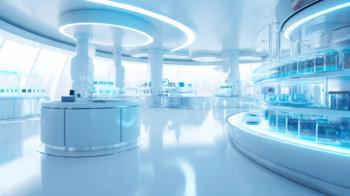Key Points:
- Kerstin Thurow from University of Rostock, Germany, highlighted that automation is essential to meet demands for higher throughput, accuracy, and cost-efficiency across industries. She projected that the lab automation market will grow from $5.2B (2022) to $8.4B (2027), driven by pharma, biotech, and environmental sectors.
- Pascal Mieville from EPFL Swiss Cat+, Switzerland, showcased full integration of HPLC and SFC in synthetic chemistry labs. A workflow can generate data for algorithm training, advancing the development of self-driving laboratories.
- Thorsten Teutenberg from IUTA, Germany, contrasted China’s fully autonomous "dark factories" with Europe's traditional lab practices. He introduced the FutureLab.NRW initiative to improve equipment
interoperability and train scientists in automation and data handling.
- Christian P. Haas from Agilent Technologies, Germany, discussed AI-powered liquid chromatography systems that optimize gradients autonomously and integrate seamlessly with digital lab environments, enhancing reproducibility and data quality.
- Tomas Leek from AstraZeneca, Gothenburg, Sweden) emphasized the need for adaptable, resource-efficient workflows in early drug discovery. He presented examples of robotic systems linking multiple labs to centralized LC–MS and NMR platforms, supporting high-throughput synthesis, predictive modeling, and compound characterization.
- Gesa Schad from Shimadzu Europe, Germany, presented a machine learning-based approach to peptide method development, using intelligent gradient optimization and flow-selection automation to streamline impurity resolution and reduce manual input.
Automation was a major focus during the early sessions of HPLC 2025, held in Bruges, Belgium, from June 14–18, 2025. In a plenary lecture following the opening ceremony on Sunday, June 14, 2025, Kerstin Thurow from the University of Rostock, Germany, emphasized the importance of automation for the global economy in her talk titled Automating the Analytical Laboratory – Current Developments and Future Directions.
Thurow pointed out that modern laboratories face increasing demands for higher throughput, improved accuracy, and cost efficiency. Automation is becoming essential, transforming operations across sample preparation, analysis, data processing, and reporting. She stated that the global laboratory automation market, valued at $5.2 billion in 2022, is expected to grow to $8.4 billion by 2027, driven by sectors such as pharmaceuticals, biotech, food testing, and environmental monitoring.
Technologies such as robotic arms, automated liquid handling, and IoT-enabled devices are enabling end-to-end workflows with minimal human intervention, enhancing both efficiency and consistency. While challenges remain—such as integration complexity, high costs, and training requirements—solutions like modular systems offer flexibility and scalability. More on Thurow’s insights can be found in her article for LCGC International’s HPLC 2025 Companion Hot Topics in (U)HPLC supplement.
Day One officially began on Monday, June 15, 2025, with an automation session chaired by LCGC International’s Pharmaceutical Perspectives columnist, and active member of ChromSoc, Adrian Clarke from Norvatis in Basel Switzerland.
Pascal Mieville from EPFL Swiss Cat+ opened the session with a presentation titled Integrating HPLC and SFC Methods into an Entirely Automated Synthetic Laboratory: On the Road Toward a Self-driving Laboratory. Mieville discussed integrating high performance liquid chromatography (HPLC) and supercritical fluid chromatography (SFC) analytical methods into a fully automated synthetic laboratory. As digital chemistry advances, data has become crucial for training algorithms that predict reaction conditions and molecular structures. Chromatography plays a vital role in generating this data, but integrating it into automated workflows—including preparation and processing—poses both chemical and technical challenges. He described the Swiss Cat+ West Hub’s approach to integration, covering workflow design, hardware setup, and algorithm development, and highlighted future directions toward self-driving laboratories powered by automation and data analytics.
Following this, Thorsten Teutenberg from IUTA, Duisburg, Germany, gave a talk titled Approaching The "Dark Lab": Can We Run It Fully Automated? Teutenberg noted that China is emerging as the world’s new industrial leader, with Xiaomi investing around $330 million in a fully autonomous “dark smart factory” running 24/7 to produce smartphones. By contrast, many European laboratories operate much as they did a century ago. In light of potential cuts in public R&D funding, Teutenberg argued that improving the skills of our next generation of scientists is critical. Achieving this requires rapid progress in equipment interoperability and training scientists to be proficient in data processing and laboratory automation. He introduced the FutureLab.NRW concept, which aims to digitize, automate, and miniaturize all laboratory processes and workflows.
Christian P. Haas from Agilent Technologies in Germany, presented Bridging Physical and Digital Worlds: The New Role of Analytical Instrumentation in the Automated Laboratory. Haas emphasized that rapid technological advances are driving significant changes in scientific labs through automation and digital integration. Analytical instruments now play a central role in linking physical experiments with digital data systems, where data quality is essential for technologies like artificial intelligence (AI) and machine learning (ML). He described how advanced software paired with liquid chromatography (LC) hardware can automatically generate reliable, high-quality chromatographic data, and how these systems integrate with other automated lab processes. His talk highlighted a machine learning-powered prototype for fully autonomous LC gradient optimization within OpenLab CDS (a chromatography data system) and concluded by stressing the importance of collaboration between users and developers to foster innovation.
Tomas Leek from AstraZeneca in Gothenburg, Sweden, spoke on Analytical Lab Automation in Early Drug Discovery Chemistry Labs. Leek noted that automated instruments such as autosamplers with integrated software have been in use for over 50 years, but developing flexible, cost-effective workflows that handle samples end-to-end remains challenging because of rapidly changing demands. Sustainability concerns are also driving the push for greater automation and resource efficiency. Leek shared practical examples involving robotics, integrated analytical tools, and data workflows tailored to evolving needs. He described fully automated single-sample analyses connecting multiple chemistry labs to a central facility for LC–mass spectrometry (MS) and nuclear magnetic resonance (NMR) data collection, supporting reaction monitoring and compound characterization. He also discussed solutions for synthesis and high-throughput experimentation in plate formats, applicable to small molecules and oligonucleotides. The talk covered predictive models for method selection and how advanced separation science and efficient workflows influence compound design. Finally, Leek highlighted the increasing use of chromatographic logD, experimental polar surface area assays, and in-silico models for physicochemical properties during drug discovery.
Gesa Schad from Shimadzu Europe in Duisburg, Germany, presented AI-Enhanced Method Development for Synthetic Peptides and Impurities. Schad described how machine learning improves synthetic peptide method development by increasing accuracy while reducing time and resources. Her research tested a target peptide and five impurities across various mobile and stationary phases. Optimization focused on gradient concentration, time, and flow rate. A single quadrupole mass spectrometer tracked peaks precisely, and resolution was visualized using a color-coded design space. An AI algorithm autonomously refined gradients to meet resolution targets, automating screening and reducing effort through flow selection valves and solvent blending. This automation minimized user input and improved efficiency, making the process more reliable.





